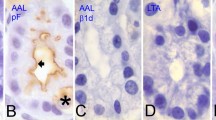Summary
Non-neoplastic prostatic epithelium from 39 patients obtained at transurethral resection for outflow tract obstruction and 5 normal prostates from men under 35 years of age obtained at postmortem were formalinfixed and paraffin-embedded. The distribution of 8 lectin receptors were studied using a peroxidase anti-peroxidase method and an avidin-biotin method. Con A, WGA, and PNA bound to most epithelial cells. Con A,and WGA also showed major stromal binding. Approximately 5% to 10% of cells bound UEA1, GS1, DBA, and BPA. No major differences in lectin receptor expression were observed between normal and hyperplastic epithelium with either of the immunohistochemical techniques except that hyperplastic cells stained more strongly than normal epithelium.
Similar content being viewed by others
References
Bischof W, Anmuller G (1982) Age dependent changes in the carbohydrate pattern of human epithelium as determined by peroxidase-labelled lectins. Prostate 3:507–513
Catalona WJ (1981) Practical utility of specific red-cell adherence test in bladder cancer. Urology 18:113–117
De Klerk DP (1983) The glycosaminoglycans of normal and hyperplastic prostate. Prostate 4:73–81
Feizi T (1985) Carbohydrate antigens in human cancer. Cancer Surv 4:245–269
Feizi T, Childs RA (1985) Carbohydrate structures of glycoproteins and glycolipids as differentiation antigens, tumour associated antigens and components of receptor systems. Trends Biochem Sci 10:24–29
Fujita J, Matsumoto K, Kishi K, Ishiyama I (1981) synthesis of ABH blood-group substances in bladder tumours. Br J Urol 53:448–452
Kay HEM, Wallace DM (1961) A and B antigens of tumours arising from urinary epithelium. J Natl Inst Cancer 26:1349–1365
Leathem A, Atkins N (1983) Lectin binding to formalin-fixed paraffin sections. J Clin Pathol 36:747–750
Leathem A, Atkins N (1983) Lectin binding to paraffin sections. In: Bullock GR, Petrusz P (eds) Techniques in immunocytochemistry, vol 2. Academic Press, London
Limas C, Lange P (1982) A, B, H detectability in normal and neoplastic urothelium. Influence of methodologic factors. Cancer 49:2476–2484
Stein BS, Kendall AR (1982) Blood-group antigens and bladder carcinoma: a perspective. Urology 20:229–233
Thorpe SJ, Abel P, Slavin G, Feizi T (1983) Blood group antigens in the normal and neoplastic bladder epithelium. J Clin Pathol 36:873–882
Author information
Authors and Affiliations
Rights and permissions
About this article
Cite this article
Abel, P.D., Leathem, A., Aylott, A. et al. Carbohydrate residues in non-malignant prostatic epithelium as revealed by lectins. Urol. Res. 15, 173–176 (1987). https://doi.org/10.1007/BF00254432
Accepted:
Issue Date:
DOI: https://doi.org/10.1007/BF00254432




